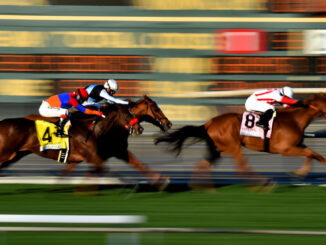
Typical Australian horse races are run over three general distance categories:
- Sprint races
- Middle distance races
- Long races
The most common distance falls in the middle there somewhere with middle-distance races making up the bulk of Australian horse racing.
Two of the country’s richest horse races are at opposite ends of the scale. The Everest boasts the most prize money, yet is only run over a distance of 1200 metres. Then there is the coveted Melbourne Cup, one of the nation’s longest horse races at 3200 metres.
What makes races like the Melbourne Cup more interesting and intriguing, apart from simply being so popular, is that a lot can happen over a longer race distance.
Back to a short race like The Everest for a moment. 1200 metres in the horse racing world is definitely a sprint to the finish. The race is practically over in the blink of an eye. If you have a “Usain Bolt” type of horse in the field running a sprint race, chances are that horse is going to win.
Shorter races simply don’t allow enough time for any variables to come into play. Perhaps the only real variable in a sprint race is whether a horse gets a good start out of the gates or not. The races are often very straight with little to no bends coming into play. Sprints are a much more straightforward kind of horse race and perhaps a little more predictable.
Now back to the Melbourne Cup, which is definitely a race for the stayers in the sport, those horses that specialise in endurance and tactical races.
Melbourne Cup odds are often all over the place for two reasons:
- Everyone in the nation is betting on the race
- Being such a long race, many variables can come into play
While a race favourite can still be first past the post in the longer races, it can be harder to pick a winner just simply because of the distance. A lot more can happen. More mistakes can be made, more bends come into play and the lead can change numerous times before the race is done.
Many of the longer races, such as the Melbourne Cup, tend to have bigger fields too. Horses and riders can get boxed in, trapped against the rails and unable to break free and make a move down the outside. A horse can have the best sprint finish out of the field, but that skill is rendered useless if they can’t break clear of the pack.
More accidents and mishaps also tend to occur in longer races and around bends. Add to that more horses on the track and there is a lot that can potentially go wrong.
It’s all these variables that actually make longer distance races infinitely more interesting. While it’s fun watching a full-on sprint race, longer races naturally take more time and practically anything can happen.
Would a race like the Melbourne Cup be such a popular spectator sport if it was only run over a distance of 1200 metres? The event would be all over in a flash, with no chance for a build-up of intensity throughout the race. There would not be enough time for many variables to come into the mix, and the pressure doesn’t have a chance to mount.
When it comes to events such as track and field at the Olympics, we’ve all marvelled at the speed and grace of the world’s best sprinters, but it’s almost always been the middle distance and long-distance races that have produced the most dramatic finishes.
It’s the same on the horse racing track, whether it’s Flemington, Randwick or elsewhere in the country. Longer races like the Melbourne Cup are just far more interesting to watch from both a spectator and punter viewpoint. It can prove to be harder to pick a race winner in many instances, but definitely a way more intriguing battle on the turf.
The way Australian thoroughbred horse racing is set up with numerous races run over varying distances means there is something for everyone, but it’s the stayer races that always produce the most spectacular results.



